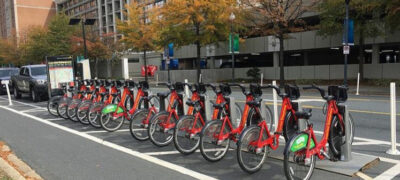New Fare Payment Systems and Payment Technology Sources and Appendix
- Date: November 9, 2022
Jump to section
Sources
Arroyo-Arroyo, F., van Ryneveld, P., & Finn , B. (2021). Innovation in Fare Collection Systems for Public Transport in African Cities. Retrieved from https://thedocs.worldbank.org/en/doc/61714f214ed04bcd6e9623ad0e215897-0400012021/original/SSATP-Fare-collection-Web-single.pdf
Automated Fare Collection System Market Size, share by 2027. Allied Market Research. (n.d.). Retrieved from https://www.alliedmarketresearch.com/automated-fare-collection-system-market
Gooch, J. (2020, July 17). Everything you need to know about account based ticketing. Masabi. Retrieved from https://www.masabi.com/2019/11/29/everything-you-need-to-know-about-account-based-ticketing/
Gooch, J. (2020, July 21). What is fare payments-as-a-service? Masabi. Retrieved from https://www.masabi.com/2019/10/28/what-is-fare-payments-as-a-service/
LIT Transit. (2020, March 23). The new trend in modern transit systems: Software as a service (SAAS). Retrieved from https://lit-transit.com/solutions/the-new-trend-in-modern-transit-systems-saas/
Littlepay. (2021, October 20). Open-loop EMV versus closed loop smart card for Fare Collection. Retrieved from https://littlepay.com/news/open-loop-emv-versus-closed-loop-smart-cards-fare-collection/
Masabi. (2016). What is ‘open-loop’ ticketing? Retrieved from https://blog.masabi.com/blog/what-is-open-loop-ticketing
Masabi. (n.d.). A guide to fare payments-as-a-service for public transit. Retrieved from https://railway-news.com/wp-content/uploads/2020/11/Masabi-Fare-Payments-as-a-Service-Guide.pdf
Mattson, J., & Mistry, D. (2021, May). Rural Transit Fact Book, 2021. Retrieved from https://www.ugpti.org/resources/reports/downloads/surtcom21-07.pdf
Office of Budget and Policy, FTA/U.S.DOT. (n.d.). 2019 National Transit Database Summaries and Trends. NTD. Retrieved from https://www.transit.dot.gov/sites/fta.dot.gov/files/2020-12/2019-NTST-1-1_0.pdf
Open ABT. (n.d.). What is account based ticketing and what are the benefits? Retrieved from https://www.openabt.com/en/inspiration/what-account-based-ticketing-and-what-are-benefits
OSPT alliance. (2011). Implementing account-based ticketing (ABT). Retrieved from https://www.osptalliance.org/assets/1/6/OSPT_ABT_eBook.pdf
Salesforce.com. (n.d.). What is software as a service (SAAS): A beginner’s guide. Retrieved from https://www.salesforce.com/in/saas/
UITP International Association of Public Transport. (2020, November). Report demystifying ticketing and Payment In Public Transport. Retrieved from https://cms.uitp.org/wp/wp-content/uploads/2021/03/Report-Ticketing_NOV2020_update.pdf
Walcott, S. (2020, May 4). Understanding the Role of Tokens in Modern Fare Collection. Retrieved from https://www.cubic.com/news-events/blogs/understanding-role-tokens-modern-fare-collection
Wolyniec, J.-P. (2020, April 20). Why ABT shouldn’t always mean EMV® in transport ticketing. Retrieved from https://www.osptalliance.org/why-abt-shouldnt-always-mean-emv-in-transport-ticketing/why-abt-shouldnt-always-mean-emv-in-transport-ticketing/
A Visual Guide to Credit Card Processing Fees & Rates. https://www.merchantmaverick.com/a-visual-guide-to-credit-card-processing-fees-and-rates-infographic/
Appendix A: Case Study Interview Guide Template
This interview template will be used to guide the development of interview questions for both vendors and transit agencies selected for the N-CATT Fare Payment Guidebook. In general, both vendor and transit agencies’ interviews will utilize the same template to ensure an efficient, focused, and guided discussion, but with modified questions by vendor/agency, as applicable. Additional questions or topics may arise during the course of discussion not presented in this guide.
Contact Information
Vendor/Transit Agency:
Vendor/Transit Agency Contact:
Date of Interview:
Content
Background: A guiding or introductory question will be developed to open the conversation and understand the vendor product or transit agency experience at a high level. Example questions include: what is the goal or vision for the product? Tell us about your experience using the platform?
Elements of Product: This section includes specific questions regarding the elements of the product. For vendors, this may include focusing on what features are unavailable or understanding how they assist transit agencies with integration. For transit agencies, this includes questions about the applicability and use of the features for customers.
Elements of discussion include:
- Open Payment
- ABT
- Fare Capping
- Purchasing Passes
- Multiple Tickets
- Trip Planning
- Cloud-base
- Hardware requirements
- Transit Rewards
- Other vendor-specific features
Partnerships:
- For vendors, questions are about the availability of fare partnerships and the ease of developing a relationship with businesses or retail outlets
- For transit agencies, questions about whether or not the agency has existing partnerships in place, if not, if they plan to introduce partnerships, and the ability to use the chosen fare platform to develop partnerships.
Benefits of Product (or Adoption):
- For vendors: questions will be developed to understand what the benefits are of the product for transit agencies and/or customers
- For transit agencies: questions will be developed to learn more about the product’s benefits, the adoption process, or the use of the technology to date.
Challenges of Product (or Adoption): As with any technology, challenges arise with new adoption or integration:
- For vendors, questions will be about understanding any challenges identified with adopters of the system (i.e., at first integration, over five years, etc.).
- For transit agencies they understood what went well, what lessons were learned, and how they overcame challenges.
Integration with existing systems: For both vendors and transit agencies, questions will ask about integration with existing systems, the design of the platform, and specific requirements for integrating the platform.
Typical Customers/Systems:
- For vendors, identifying the typical customer demographics or transit agencies
- For transit agencies, understand how they use the platform, who the users are, and their applicability for rural or urban systems.
Ease of use:
- For vendors, questions will be asked about the extent of usability for both agencies and riders
- For transit agencies, understanding how user friendly the software is for both external and internal use
Costs: For both vendors and transit agencies, questions will be developed to identify the actual or range of capital costs, operating costs, and other costs incurred
Operating Requirements: There are questions regarding the necessary operating requirements, ease of implementation, and compatibility with existing systems for vendors and transit agencies.
Request demonstration of product:
- For vendors, interviewees will request a demonstration of the product to understand and view the platform from the agency and user perspective
- For transit agencies, questions will be about data collection and how they operate with the product internally.
Other: As time permits, additional questions will be asked of both the vendor and transit agency contact; for example, is there any additional information you would like to share? Or to allow the opportunity to ask additional follow-up questions for topics discussed throughout the interview.

